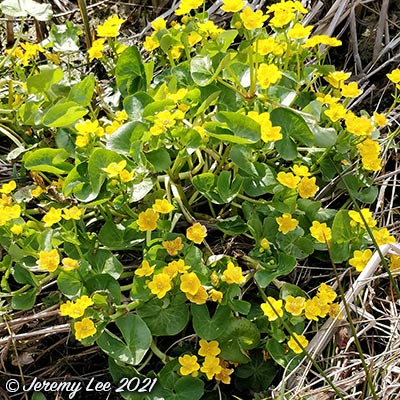
 |
|
Scientific Classifications explained » Amphibians » Ants » Aphids » Bees » Beetles » Birds » Bugs » Butterflies » Caterpillars » Damselflies » Dragonflies » Earwigs » Flies » Frog/Leafhoppers » Fungi » Galls » Grasshoppers » Harvestmen » Hoverflies » Lacewings » Ladybirds » Leaf Mines » Lichens » Mammals » Millipedes » Mosses » Moths » Sawflies » Slugs » Snails » Spiders » Trees » Wasps » Wild Flowers » Woodlice |
UK Nature > Wild Flowers > Yellow Wild Flowers > Caltha palustris

Scientific Name: Caltha palustris Common Name: Marsh Marigold Caltha palustris, more commonly known as Marsh Marigold or Kingcup, is most often found in soggy, ground such as wet woodland, ditches, stream margins, ponds, bogs and marshes. It is a perennial plant with striking, shiny golden flowers (10-50mm across) from April to July, each flower comprised of 5 – 9 oval sepals, there being no petals and at the centre of each are numerous stamens crowded together. The flowers are held in loose, clusters on stout, hollow stems which also bear deep green, kidney shaped, fleshy leaves which increase in size after the plant has flowered. This is a native plant, widespread in the UK, and it belongs to the buttercup family Ranunculaceae. It is poisonous if ingested in large amounts. |
|

https://www.uknature.co.uk is a website dedicated to showing the immense diversity of UK nature and wildlife. Our vast range of habitats, from lowland arable to snow covered mountains, from storm-ravaged coastlines to peaceful inland freshwater lakes and rivers, from dry, sandy heaths to deciduous and coniferous forests, all these habitats contribute to the abundance of UK nature. We have wild birds in huge numbers either residing or visiting our shores (597 recorded species as at July 2013) and we must also not forget the humble back garden with its grass lawns, flower beds filled with nectar rich flowers, shrubs and trees, all designed to attract huge numbers of insects such as bees, moths, butterflies and hoverflies; and finally the small ponds which provide safe havens for frogs, toads, newts and even slow worms and grass snakes. www.uknature.co.uk is the showcase for my personal passion, photographing uknature in all its glory. I sincerely hope you all enjoy the fruits of my labours. This site and all images contained therein is © Jeremy Lee 2004 - 2021. All Rights Reserved. Site design by Jeremy Lee. Site development & IT Support by Stuart Lee. |